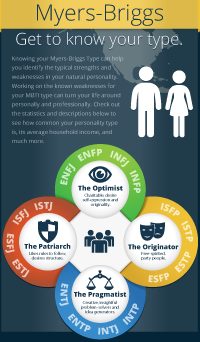Career Tips for ESTP Personality Types (Extraverted-Sensing-Thinking-Perceiving).
Some make an occupational decision in high school or college, and others decide to make career changes after many years in the workforce. Regardless of the timing, choosing or changing careers is a major and often stressful decision. The opportunities and options seem endless, and finding the right fit can feel overwhelming. The Myers-Briggs Type Indicator® (MBTI®) is a great way to organize thoughts regarding career choice. The Myers-Briggs® Test was inspired by Carl Jung’s theory of type. It classifies people into 16 types of categories based on characteristics. Isabel Myers and Katharine Briggs developed an indicator to identify connections between personality features, including how introverted or extraverted a person may be, how they make decisions, and more. The MBTI® can connect specific personality types with employment. For example, a person who has a Judging preference prefers to operate on strict schedules and, therefore, might want to avoid creative workplaces that tend to be more flexible, which is more suitable for a Perceiving type. Those who are highly introverted might prefer careers such as accounting or research rather than teaching or counseling. The MBTI® can be a valuable starting point for narrowing down occupational choices to efficiently focus on those careers that best-fit one’s personality.

Read about The Myers-Briggs® Test ESTP Personality Type Career Tips and other Occupational Information
ESTP Personality Types (Extraverted-Sensing-Thinking-Perceiving) and Career Choice.
ESTPs are flexible and tolerant individuals in their personal and professional lives. They are highly social and live life by focusing on the present. They value immediate gratification and payoff, from financial windfalls to spontaneous trips, and make decisions that are based on logic and facts. They are more likely to choose options that lead to short-term gain than to patiently wait for their day to come. From an ESTP’s perspective, life doesn’t just “happen” – it transpires from what one makes of it. As such, ESTPs are inherently active people who learn best through doing things such as exploring and engaging with the world around them. This is as true in the workplace as it is outside it. In professional settings, ESTPs acquire new skills most effectively by experimenting and practicing them rather than by reading theories or concepts. Someone who is pitching an idea to an ESTP should focus on the practical implications of the proposal and be cautious not to get lost in theoretical details. ESTP personality types care far more about the logistics and impact of an initiative than they do about the theoretical value or contributions of those ideas.
ESTPs are known for their entrepreneurial, creative responses to challenging situations, working with ease when pressure is high. Rather than assuming that conventional procedures or approaches are the best simply due to establishment, ESTPs do not hesitate to find innovative solutions. This personality type rarely allows standard operating procedures or rules to limit themselves and instead finds new ways to use established systems. For example, if their company has an outdated file-naming system that requires hundreds or even thousands of files to be re-named manually, an ESTP might suggest hiring a programmer to write code to automate the process, saving the company time and money. Their creativity also extends to interpersonal human relationships. For instance, ESTPs are often able to bridge disagreements or rifts between different groups of people and are often able to encourage them to reconcile in order to achieve a common goal. They also find novel approaches to solving interpersonal problems and enjoy taking part in team building or other activities that are designed to bring people together. Far from being controlling or authoritarian in these settings, ESTPs are popular teammates and companions because of their passion, perseverance, and their ability to enjoy the moment. ESTPs approach problems in a rational and practical manner and are experts at identifying the needs of a particular moment and reacting quickly to meet them. They often avoid thinking too much about the long-term implications of their decisions, as to them, filling a short-term need is far more important. They also tend to stay flexible while implementing their solutions, which allows them to adapt to changing circumstances quickly and effortlessly. One of the greatest challenges for ESTP personality types, especially in professional environments, is their difficulty in setting and adhering to priorities. To them, the most important problem is the one they are confronting at the moment, and they may fail to see how a possible response could cause a chain reaction that affects other people and projects. As a result, colleagues may feel that ESTPs are not reliable or organized. Another challenge for ESTPs is their need for affirmation – that their contributions are noticed and appreciated and that they are valuable, contributing members of their teams. ESTPs and their colleagues should make an effort to build a support network, even in professional environments, and set reminders to ensure important deadlines are met.
ESTPs can be valuable in many types of careers in a broad range of industries, from aviation or engineering technician to bartending. This personality type is also often found in careers in forestry, inspection, transportation, or the military. While these may seem very different from one another, they all have two things in common: they involve careful attention to detail and the ability to be dexterous. As an added bonus, they also generally consist of a series of small tasks, like completing a successful flight or mixing and serving the perfect drink, rather than a smaller number of major tasks, like laboratory technicians researching a new innovation or scientific principle. The careers that ESTPs thrive in intend to have milestones every day rather than every few months or even years. In addition, they also often involve an inclination to take chances and the ability to manage crises on a daily basis. Some careers in which ESTP personality types have shown happiness are Automotive Specialty technicians, Construction Laborers, Counter and rental clerks, electricians, Farm and Ranch Managers, Firefighters, Freight handlers, Loan Officers, Restaurant cooks, and Construction supervisors.

Read about The Myers-Briggs® Test ESTP Personality Type Career Tips and other Occupational Information
ESTP Personality Types Goal Setting and Gathering Information.
The first step to exploring career options is to set goals. In general, ESTPs set short-term, primary goals and utilize unanticipated opportunities to achieve those goals. Because of ESTPs’ tendency towards spontaneity, they may have difficulty creating a long-term plan with concrete, specific action steps to help them achieve their goals. To keep them on track, ESTPs may want to enlist the help of a friend who thinks more linearly and who is willing not only to plan the next steps but also to keep ESTP personality types accountable as they begin taking steps to progress along their career paths. Once goals are set, and a path is established, the next step is to gather information. Because ESTPs are so social, the best way for them to learn more about a career is often by reaching out to other professionals who have experience in their targeted field. For example, an ESTP who wants to be a pilot could try reaching out to flight school instructors, current pilots, or even leaders in the airline industry. Not only is this a great way to find out more about the career, but it is also a way to get an insider’s perspective on the day-to-day responsibilities of professionals before fully committing to a course of action. Having these conversations could also help identify key steps that they missed during their initial planning process. During this step of the career exploration process, ESTPs should try not to get defeated by the specifics. If they discover new considerations or actions needed, they can organize the steps on a timeline. They might find that even though there are many individual steps spread out over weeks, months, or even years, there are just a few tasks to focus on at a time. Most importantly, ESTPs should take the long-term benefits of career selection into consideration prior to making a decision.
ESTP Personality Types and Networking.
As ESTPs reach out to potential contacts, they also need to think about how to have these conversations with professionals. One strategy is to make the final goal clear to their chosen mentor by telling them what career they would like more information about and how their mentor can personally assist with specific goals. The questions should be as explicit as possible and should stay focused on the target career, employer, or industry. These meetings are also wonderful preparation for any future interviews. Typically, this personality type will have connections that extend beyond the necessary networking campaign and should make a list of relevant contacts in order to avoid ineffectual communications. In order to ensure time is properly used, an ESTP should bring a list of prepared questions and set a limit for the amount of time spent with each connection. ESTP personality types should also practice communication skills such as being aware of interrupting and learning to pause, allowing others to ask or answer questions as well.
ESTPs should ask their mentors what type of interview questions to prepare for and practice questions that may introduce hypothetical scenarios. One strategy is to bring along a resume and ask what areas of improvement the mentors notice, especially if the contact has experience with hiring. ESTPs should remember to consider the interviewer’s personality dichotomy and not overpower an Intuitive person with specifics. Understanding how to approach different personality types will ensure the ability to lead the conversation.
ESTP Personality Types and Decision-Making.
ESTP job-seekers typically feel they have enough information to make an informed decision by weighing the pros and cons of each option. When preparing this comparison, in addition to standard considerations, they should also think about geographic location and how the final decision might ultimately affect others in their lives. Often this personality type will neglect their personal values only to consider informational facts. For instance, if the new position requires a longer commute, an ESTP should consider how it will affect time taken from friends and family. Furthermore, ESTP job-seekers who are considering opportunities that may require them to relocate may need to think about what prospective opportunities their spouse or significant other might have in the new location. Those with children should consider the quality of schools and the proximity of extracurricular activities in the area as well.
Another potential obstacle for this personality type is delaying their decision. Having deadlines set for all steps of the career exploration process will allow ESTPs to make decisions in a timely fashion. Sharing these deadlines with loved ones or visually posting them in places that are seen daily have been tools which deem beneficial for this personality type. Once a decision is reached, they should take the time to share the wonderful news and celebrate! ESTP personality types can find it easy to get swept up in the logistics of a career change and forget to feel happy and satisfied –even though happiness and satisfaction are the reasons for making a change, to begin with. As an ESTP, working for a long-term goal like this can be challenging and even demoralizing at times, finding moments of joy and happiness along the way is important. The MBTI® can be used as a guide to help decisions and build confidence allowing for progress in the right direction.
Learn More About the MBTI ESTP Personality Type
Explore additional information that delves deeper into the ESTP Personality Type by examining various personality and career-based subjects:
- How the MBTI ESTP Type relates to Innovation
- How the MBTI ESTP Type relates to Project Management
- How the MBTI ESTP Type relates to Emotional Intelligence
- How the MBTI ESTP Type relates to Leadership
- How the MBTI ESTP Type Communicates
- How the MBTI ESTP Type relates to Decision Making
Click on the link below to read more about different MBTI Personality Types
| ISTJ | ISFJ | INFJ | INTJ | ESTP | ESFP | ENFP | ENTP |
| ISTP | ISFP | INFP | INTP | ESTJ | ESFJ | ENFJ | ENTJ |
References
Introduction to Type (Isabel Briggs Myers, 1998, CPP Inc.)
Introduction to Type and Careers (Allen L. Hammer, 2007, CPP Inc.)



